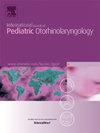什么对谁有用?腭裂儿童及青少年个性化言语干预的系统综述
IF 1.2
4区 医学
Q3 OTORHINOLARYNGOLOGY
International journal of pediatric otorhinolaryngology
Pub Date : 2025-05-19
DOI:10.1016/j.ijporl.2025.112401
引用次数: 0
摘要
目的:个性化的医疗保健包括针对个体的独特特征而进行的干预。尽管个性化干预在过去的几十年里得到了越来越多的关注,但在唇腭裂儿童(CP±L)的言语和语言干预领域,这一主题尚未得到系统的研究。本系统综述的目的是总结个性化言语干预对3-18岁CP±L儿童的影响的证据,重点关注前口、后口和非口唇裂的言语特征。方法本系统文献综述遵循PRISMA(系统评价和荟萃分析的首选报告项目)指南。检索Cochrane Central Register of Controlled Trials (Central)、MEDLINE(通过PubMed)和Embase,并检查灰色文献。搜索策略基于三个概念:腭裂、言语干预和儿童。两名评分员独立确定入选资格,并从纳入的研究中提取所有相关数据。纳入研究的方法学质量也使用QualSyst工具进行评估。结果本综述纳入4项研究。纳入研究的总体质量良好。研究发现,具有严重非唇裂言语特征的儿童可从基于运动语音的干预策略中获益。相比之下,语言语音策略在改善言语和与健康相关的生活质量方面更有效,这些儿童的言语特征不太严重,前口腔或后口腔唇裂。结论:有证据表明,个性化的言语干预比“一刀切”的方法效果更好。进一步的研究,特别是随机(假)对照试验,需要证实这些结果。本文章由计算机程序翻译,如有差异,请以英文原文为准。
What works for whom? A systematic review on personalized speech intervention in children and adolescents with a cleft palate
Objective
Personalized health care involves intervention that is tailored to the unique characteristics of the individual. Even though personalized interventions have gained more attention in the past decades, this topic has not yet been systematically studied in the area of speech and language intervention in children with a cleft (lip and) palate (CP ± L). The aim of this systematic review is to summarize the evidence of the effects of personalized speech intervention in children with a CP ± L, aged 3–18 years, with a narrow focus on anterior oral, posterior oral, and non-oral cleft speech characteristics.
Methods
This systematic literature review was developed following the PRISMA (Preferred Reporting Items for Systematic Reviews and Meta-Analyses) guidelines. The Cochrane Central Register of Controlled Trials (CENTRAL), MEDLINE (via PubMed), and Embase were searched and the grey literature was checked. The search strategy was based on three concepts: cleft palate, speech intervention, and children. Two raters independently determined the eligibility and extracted all relevant data from the included studies. The methodological quality of the included study was also assessed using the QualSyst tool.
Results
Four studies were included in this review. The overall quality of the included studies was good. Children with severe, non-oral cleft speech characteristics were found to benefit from motor-phonetic based intervention strategies. Linguistic-phonological strategies, in contrast, were more effective in improving speech and health-related quality of life in children with less severe, anterior oral or posterior oral cleft speech characteristics.
Conclusion
There is some evidence that personalized speech intervention yields better outcomes than a “one-size-fits-all” approach. Further research, especially randomized (sham-)controlled trials, is necessary to confirm these results.
求助全文
通过发布文献求助,成功后即可免费获取论文全文。
去求助
来源期刊
CiteScore
3.20
自引率
6.70%
发文量
276
审稿时长
62 days
期刊介绍:
The purpose of the International Journal of Pediatric Otorhinolaryngology is to concentrate and disseminate information concerning prevention, cure and care of otorhinolaryngological disorders in infants and children due to developmental, degenerative, infectious, neoplastic, traumatic, social, psychiatric and economic causes. The Journal provides a medium for clinical and basic contributions in all of the areas of pediatric otorhinolaryngology. This includes medical and surgical otology, bronchoesophagology, laryngology, rhinology, diseases of the head and neck, and disorders of communication, including voice, speech and language disorders.

 求助内容:
求助内容: 应助结果提醒方式:
应助结果提醒方式:


